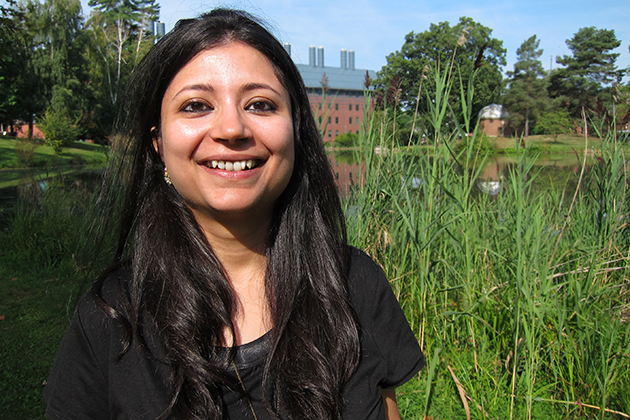
In her medical and health geography class last spring, assistant professor Debarchana (Debs) Ghosh asked her students to do something a bit odd: to look for terrible food.
“I asked them to go to their neighborhood and find the highest-calorie food they could for just one dollar or less,” she says.
The students expected to come back with tales of sugary processed foods. But what astounded them was the sheer size of food they could acquire for a mere buck.
The winner was a pre-wrapped package of sixteen pieces of pie for 96 cents, containing 6,880 calories.
“It makes a point,” says Ghosh. “If someone is struggling with money and has to feed their family, that’s what they’re going to choose: the cheap, calorie-rich foods in their neighborhood.”
Ghosh’s research centers around just this fact. From the availability of fresh foods to poor people in Hartford, to the accessibility of drugs to HIV sufferers in India, Ghosh wants to know how where people live affects their daily health choices.
Lost in the desert
Food deserts, or regions where access to healthy food is scarce, are common in poor sections of cities. When the nearest produce is sold in a grocery store even as little as a mile away, city residents often don’t have the time or the resources to get there.
In many cases, there’s also a compounding factor of the relative availability of unhealthy foods. If the supermarket is a mile away but there’s a McDonald’s around the corner, which will people choose more often? Ghosh says the answer is clear.
“It’s a double-edged sword,” she says. “If your closest choice is bad foods, that might mean you choose that more frequently.”
Ghosh, who joined UConn last fall, wants to add the availability of unhealthy foods to the definition of a food desert. She was recently awarded a grant from the CLAS Bennett Fund for Innovative Education in Health and Society, which supports programs and undergraduate education addressing the social aspects of human health.
With the funding, she will teach a hands-on course that helps students better understand people’s lives in food deserts. Undergraduates will go into communities in Hartford, East Hartford, and West Hartford, and guide local teachers, community leaders, and parents to document the foods people around them eat through photography.
“We’re trying to collect data from their point of view, within each neighborhood,” explains Ghosh.
Students will also analyze food receipts from community members over the course of six months, to understand what people are eating, where they are buying it, and how often they go grocery shopping.
“Where we live has an effect on the choices we make,” Ghosh says. “You need a significant behavioral intervention to convince someone to go two neighborhoods away to get fresh food groceries.”
Social stigmas
Across the globe, Ghosh’s research takes on another geographical problem: access to health care. In West Bengal, India, people who are HIV-positive or have the AIDS virus vary greatly in their proximity to clinics that provide the antiretroviral drug that can slow the disease’s progress. If there are two or three clinics in a district – similar in size to a U.S. Census tract, she says – how does that relate to the number of people close by who actually have the disease?
“There’s a layer of stigma that goes with having the disease and traveling to one of these centers,” Ghosh says. If access to the centers is convenient and discreet, people are more likely to actually pick up and take their medicine.
This summer, Ghosh was awarded a UConn Faculty Large Grant to travel to West Bengal. There she spoke with members of high-risk communities, including a brothel. Many female sex workers said they wouldn’t want to get tested for HIV because there aren’t testing centers in their area – and anyway, if they found out they did have HIV, they’d be out of a job.
“Testing has been a big challenge,” says Ghosh. “The Indian government is trying to spread the benefits of testing and remove the stigma of it.”
Ghosh’s work in India will involve combining traditional geographic mapping and analyses with the use of surveys and questionnaires to understand the behavior of at-risk populations.
That combination, says Ghosh, is something she loves about her work.
You can do that?
Ghosh has always liked “asking spatial questions,” as she puts it. After her undergraduate and master’s studies in Calcutta and New Delhi, India, she earned her Ph.D. studying the medical geography of the West Nile virus at the University of Minnesota.
But, she says, “You don’t build things in a vacuum.” The public, social side of geography is also crucial, she says, to improving health policy. So combining the two seems the natural way for her to approach her research.
It also tends to surprise some people, especially those who think the study of geography is simply learning the capitals of the world’s countries.
“It makes me happy when I hear people say, ‘You can do that in geography? I didn’t know you could do that in GIS!’” she says. “I tell them, yes, you can.”



